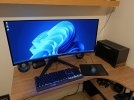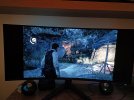Yes but saying Starfield is an excellent example of widescreen when it has limitations of how wide it can be makes it not an excellent exampleOP's monitor, and mine, are 21:9... Which is plenty difference from the 16:9 he's accustomed to.
Install the app
How to install the app on iOS
Follow along with the video below to see how to install our site as a web app on your home screen.
Note: This feature may not be available in some browsers.
You are using an out of date browser. It may not display this or other websites correctly.
You should upgrade or use an alternative browser.
You should upgrade or use an alternative browser.
Alienware Ultrawide OLED on sale £660 on Amazon.
- Thread starter davis.anthony
- Start date
I take it this is no longer your opinion ?The black level is still awesome but going back to mini LED with FALD I've realised how much I had to give up to use an OLED and it's simply not worth it.
Having 3x the brightness for HDR is more impactful to the image than that extra 15% deeper blacks.
davis.anthony
Veteran
I take it this is no longer your opinion ?
The LG OLED was such a massive downgrade in terms of HDR that if I had the choice between the Cooler Master mini-LED or the LG OLED I would go with the mini-LED, so that particular opinion I still have.
But, I would go with this Alienware OLED over the mini-LED as it's HDR brightness is vastly superior to the LG OLED and on par with the mini-LED.
Last edited:
davis.anthony
Veteran
It's an excellent example for the person I was speaking to, who has a 21:9 monitor.Yes but saying Starfield is an excellent example of widescreen when it has limitations of how wide it can be makes it not an excellent example
Not really sure if there's any true comparison, but I went with the 85" Samsung NEO QN95 which features their mini-"QLED" panel and I'm absolutely in love with it for home media use.The LG OLED was such a massive downgrade in terms of HDR that if I had the choice between the Cooler Master mini-LED or the LG OLED I would go with the mini-LED, so that particular opinion I still have.
But, I would go with this Alienware OLED over the mini-LED as it's HDR brightness is vastly superior to the LG OLED and on par with the mini-LED.
arandomguy
Veteran
that rtings test is absolute WORSE CASE.
Kind of. What's interesting about these accelerated test cases is that while they are worst cases (due to the nature of them needing to be accelerated) in terms of the content display pattern (well kind of again) they actually don't tend to be in terms of environmental conditions.
For instance I don't think it's widely considered but the organic materials in OLEDs actually are non trivially impacted by UV radiation. Which means in theory a display exposed to say even indirect sunlight over 5 years is not the same as one with only 1 year of exposure even if the power on and image might be the same.
The absolute worst case would likely be the same test pattern in a room that did have sun lit conditions along with say a less optimal temperature range (which does affect OLED degradation as well) plus humidity.
Also circling back to the test pattern, are tests with a relatively static test pattern actually the worst case given modern mitigation techniques? At least I would think accommodating for that heuristically would be relatively simple compared to a more random/distributed scenario. A crude example for instance let's say you had 1/4 the screen only, it seems like you could rather easily accommodate for that algorithmically.
Last edited:
The latest Rtings report highlights two issues, though. One is accelerated burn-in through bright static elements (the CNN logo in the case of Rtings). Actually, the OLED monitors, even the QD-OLED ones did fine there, the panel refresh measures were able to clean any image retention, and only in extreme 5% grey slides were traces of permanent burn-in visible (see the picture below). I'm sure with careful handling like turning down the brightness, hiding icons and taskbar one could mitigate it further.
However, the picture below also highlights the second issue, namely uneven wear from watching content in a different aspect ratio on an ultrawide screen. Here Rtings claims it took only 700 hours for it to become visible. They called it the "reverse burn-in" scenario. The accelerated differential wear is not only because the OLEDs in the centre wear off while the ones on the sides are off but also because the monitor sends more power to them since only part of the screen is lit. I don't know whether LG mitigated this issue on their models (watching 21:9 content on those screens would be the equivalent). In real-world content it's not as visible as in 5% slides obviously, Rtings claims it manifests as, e.g., lifted shadows on the sides when watching a dark scene and it's a kind of "cannot unsee" thing if you notice it.
I guess 700 hours can be both a lot and a little, depending on how many hours of 16:9 content one would watch (1 hour daily equals ~ 2 years, 2 hours ~ 1 year). For this reason, their stance is to recommend the screens only for gaming use, while not when used for other things like productivity. As for mitigation measures, I guess it's not that easy. Apart from the obvious "avoid 16:9 content", one could potentially watch 16:9 in a window. If I remember correctly, that's what @Silent_Buddha does on his LG OLED when playing 21:9 content. Then again, one could also ignore everything I've just written and just RMA the thing under the 3-year burn-in warranty if the worst happens. I read that the warranty does not guarantee getting a brand-new unit, though, and you could get a refurb.
I read that the warranty does not guarantee getting a brand-new unit, though, and you could get a refurb. 

Link to the part about monitors:
However, the picture below also highlights the second issue, namely uneven wear from watching content in a different aspect ratio on an ultrawide screen. Here Rtings claims it took only 700 hours for it to become visible. They called it the "reverse burn-in" scenario. The accelerated differential wear is not only because the OLEDs in the centre wear off while the ones on the sides are off but also because the monitor sends more power to them since only part of the screen is lit. I don't know whether LG mitigated this issue on their models (watching 21:9 content on those screens would be the equivalent). In real-world content it's not as visible as in 5% slides obviously, Rtings claims it manifests as, e.g., lifted shadows on the sides when watching a dark scene and it's a kind of "cannot unsee" thing if you notice it.
I guess 700 hours can be both a lot and a little, depending on how many hours of 16:9 content one would watch (1 hour daily equals ~ 2 years, 2 hours ~ 1 year). For this reason, their stance is to recommend the screens only for gaming use, while not when used for other things like productivity. As for mitigation measures, I guess it's not that easy. Apart from the obvious "avoid 16:9 content", one could potentially watch 16:9 in a window. If I remember correctly, that's what @Silent_Buddha does on his LG OLED when playing 21:9 content. Then again, one could also ignore everything I've just written and just RMA the thing under the 3-year burn-in warranty if the worst happens.

Link to the part about monitors:
Silent_Buddha
Legend
Apart from the obvious "avoid 16:9 content", one could potentially watch 16:9 in a window. If I remember correctly, that's what @Silent_Buddha does on his LG OLED when playing 21:9 content.
I do this for everything, especially games. This way I can change the window location of the content from time to time so static HUD elements aren't always in the same place. Likewise if the game likes to have "dead space", usually at the top and bottom to simulate a cinematic wide screen effect on a 16:9 display, but also when playing older games with a 4:3, 5:4 or 16:10 aspect ratio. Being able to change where the game is located helps to mitigate any effects of "reverse burn in" from that.
Regards,
SB
davis.anthony
Veteran
I plugged the LG 1440p OLED nack in and I'm not sure.
It's looks way more contrasty than this Alienware, it's not the difference in screen coating either as I'm currently in the man cave with the blind shut and all the lights off so there shouldn't be anything that affects the black level on the Alienware.
I also still wish the stand would go higher than it does.
It's looks way more contrasty than this Alienware, it's not the difference in screen coating either as I'm currently in the man cave with the blind shut and all the lights off so there shouldn't be anything that affects the black level on the Alienware.
I also still wish the stand would go higher than it does.
davis.anthony
Veteran
Yeah, there are a few games out there that refuse to run at anything wider than 16:9... It's usually older games of course, sometimes you can find mods to allow the updated rez.
I don't know about the LG, but I know 100% the Alienware is a 21:9 aspect monitor just like mine, and Starfield 100% absolutely positively supports 21:9 resolutions. The only exceptions are the brief pre-rendered cutscenes like when you gain one of the dumb temple powers which are rendered in 16:9.I had to play starfield like that
Do you really need to ask that? It's perfectly fine to simplify it to "4k" for quickly recognizable features, rather than having to show full resolutions on marketing materials, boxes, product summaries etc.Why are they called 4k when 1k in common usage = 1,000 and in the computer world 1k = 1024 ?
1080p is commonly referred to as 2k nowadays as well. Numbers are good for marketing as well since bigger numbers = better. And lastly, having a simple term that is actually tied to the resolution is much better than the public having to remember what "WQHD" and other such stuff refers to.Yes, 1920x1080 was called HD not 2k 2HD would have been better (/Davros suddenly realises he is a marketing genius)
Except it's not tied to the resolution is it. If the resolution was 2,000 or 2048 I'd agree with you

And yet you refer to it as 1080p1080p is commonly referred to as 2k nowadays as well
Last edited:
Similar threads
- Locked
- Replies
- 121
- Views
- 19K
- Replies
- 18
- Views
- 3K


